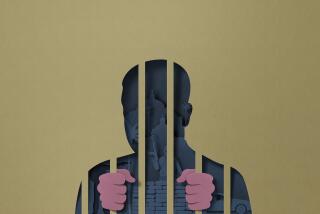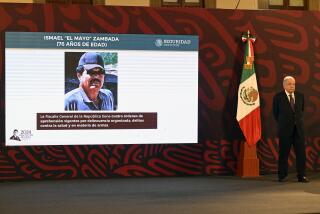Arms Drop for Contras in 1986 by CIA Alleged
- Share via
WASHINGTON — A Central Intelligence Agency helicopter illegally delivered at least one cargo of plastic explosives to rebels inside Nicaragua last year, according to an American crewman aboard the flight and two other sources.
Their account is the first confirmed report of a direct violation by CIA employees of the Boland Amendment, which prohibited the agency from providing weaponry to the contras from late 1984 through late 1986.
The crewman, who was working for the contras’ private airlift at the time, said that an unmarked Bell UH-1H helicopter carried between 200 and 400 pounds of plastic explosives to a landing zone inside Nicaragua from the rebels’ air base at Aguacate, Honduras, on May 13, 1986.
“We unloaded in the Bocay area (just inside Nicaragua),” the crewman, Iain Crawford of Fayetteville, N.C., said in an interview. “We dumped it on the ground as fast as we could and the contras picked it up and scurried away.”
Two Confirm Account
His account was confirmed by a former U.S. official and by a ranking contra officer who said that CIA personnel made several such supply flights for the rebels.
“They made a lot of flights for us,” the contra said. “Some carried explosives and others equipment. Maybe it was against the rules, but they were trying to help us out.”
A spokesman for the Senate Intelligence Committee said that such flights were clearly prohibited at the time.
“If they delivered explosives, that would be illegal,” spokesman David Holliday said. “The CIA was allowed to do some things for the contras (in May, 1986), but they surely didn’t include delivering explosives.”
Kathy Pherson, a spokesman for the CIA, said she could neither confirm nor deny the reported flights except to say: “The agency has complied with all congressional restrictions.”
Congress barred the Reagan Administration from providing or transporting military aid to the rebels from Oct. 12, 1984, until last Oct. 17. Congress approved $27 million in non-military aid for the rebels during that period but specifically prohibited the CIA from delivering it.
In addition, in an attempt to avoid exposing American officials to combat, Congress barred U.S. government personnel from going into Nicaragua with the contras.
Pilot Hit by Fire
On a March, 1986, CIA helicopter flight across the border, however, Nicaraguan troops opened fire on the helicopter, damaging the aircraft and hitting the American pilot in the leg, the contra said.
“He was a very good pilot, because he got the helicopter down without killing anyone,” he said.
Crawford, who spent five months working for the contras’ private airlift operation, said he learned of that incident several weeks later when the CIA brought a big CH-36 Chinook helicopter down to the Nicaraguan border to lift the damaged chopper out.
Crawford, 31, now the owner of a parachute rigging firm, said he knew one of the CIA officers at Aguacate--a man who used the code name “Mick”--from a previous meeting when Crawford was in a U.S. Army special operations unit.
No Doubts About CIA
“There was no question about his being CIA,” said Crawford, who spent 11 years in the Army. “The contras knew it, I knew it, everyone knew it. . . . Mick talked about the congressional restrictions, how their hands were tied a lot.”
He said Mick organized parachute training for a small group of contras but complained that the CIA’s rules prohibited him from helping the guerrillas with weapons training.
Mick and another CIA officer who used the code name “Moe” lived apart from the contras in a small shack outfitted with a satellite antenna dish, two racks of radio equipment and a “situation board” showing the disposition of contra troops and the forces of the Nicaraguan government, Crawford said.
‘Pilots Were Americans’
As for the helicopter, he said: “The pilots were Americans. They wore survival vests and sat in armored chairs. This was new equipment. It wasn’t the contras’ and it wasn’t (the private airlift operation’s). It was clearly agency.”
The helicopters, which included several UH-1H “Hueys” and Hughes 500-Ds, came through Aguacate “roughly every other day,” Crawford said. He said they were painted dark green or black and carried no military or national insignia.
On May 13, Crawford said, he asked Mick if he could ride on one of the Huey flights, and Mick agreed. Crawford said there were four other men aboard: a pilot and co-pilot, both of whom appeared to be American, an unidentified Latino and Mick.
Explosives ‘Clearly Marked’
“The cargo was about 80% food--bags of rice,” he said. “And there was about 200 to 400 pounds of plastic explosive. . . . It was in wooden boxes. It was clearly marked.”
In fact, Crawford said, the boxes appeared to be from a load of plastic explosives he had helped fly from El Salvador to Aguacate a month earlier.
“We flew just the other side of the river,” he said, referring to the Rio Coco, which forms the border between Nicaragua and Honduras. “Where we landed I can’t testify exactly, but it was just the other (Nicaraguan) side of the river.”
Crawford said he has already given his account to investigators from the Senate and House committees investigating the Reagan Administration’s secret arms sales to Iran and aid to the contras. Congressional sources confirmed that and said the two panels are seeking corroboration for the story.
Refers to Date Book
Crawford, who referred frequently during the interview to his 1986 date book, said he was hired for the private airlift on Jan. 6, 1986, by Richard Gadd, a former Air Force officer and business associate of retired Air Force Lt. Gen. Richard V. Secord, an active participant in the effort to supply the contras.
He displayed several documents confirming that account, including an identification card issued by the Salvadoran air force providing entry to El Salvador’s main air base at Ilopango, where the airlift was based.
Crawford said he had worked as a load master and “kicker” on 40 to 50 airlift flights, most of them dropping cargo by parachute to contra units near Bocay and Rus Rus to the east.
Although the State Department sought to separate the delivery of its own non-military aid from the contras’ weaponry, Crawford said: “There was no segregation whatsoever. It wasn’t even dreamed of. . . . There was maybe one load of completely humanitarian aid out of 40 or 50.”
Invited to Briefing
At one point, he said, Gadd asked Crawford to join him on an executive jet flight back to the United States so that he could brief three other men on the airlift operation’s problems.
One of the three, he said, was Marine Lt. Col. Oliver L. North, then a White House aide. Another was Secord, who was helping North organize the airlift, as well as the Administration’s secret arms shipments to Iran. Crawford said he still does not know who the third man was but noticed that, like North and Secord, he carried a purple U.S. diplomatic passport.
Crawford said he agreed to work for the secret airlift because he agrees with the contras’ cause but also because “I love covert operations. . . . And the money wasn’t bad.”
Pay for Crossing Border
He said he was paid $150 per day plus expenses. “We were promised $500 (extra) every time we went across the border, but nobody I know ever got paid that,” he said.
But he soon found that the operation was mismanaged, starved for funds and saddled with faulty equipment.
“The cheapness of the operation was amazing,” he said. “The Caribou (cargo plane) we were using had holes in the dashboard. We weren’t using navigational equipment to get to the drop zones, just maps. And there weren’t any parachutes or safety straps; you just hung on.
“We also learned that we were supposed to be getting $300 a day, but were only getting $150.”
Repeated Complaints
Crawford said he was fired from the project last May after complaining repeatedly about the airlift’s equipment and management problems.
He said he decided to “go public” after Nicaraguan troops shot down one of the planes last Oct. 5, killing three crewmen and capturing Eugene Hasenfus of Marinette, Wis. The plane had reportedly suffered from chronic engine trouble and was off course when it was hit.
“I decided,” Crawford said, “that people should know how this thing was mismanaged.”
More to Read
Sign up for Essential California
The most important California stories and recommendations in your inbox every morning.
You may occasionally receive promotional content from the Los Angeles Times.











